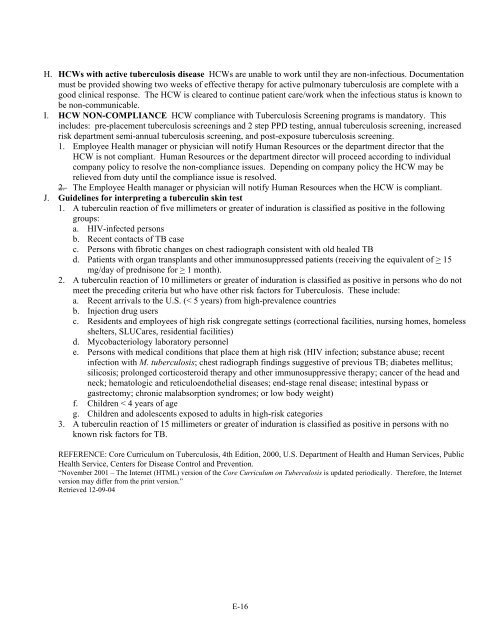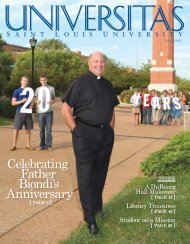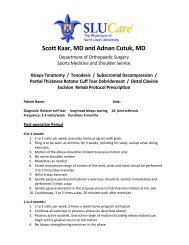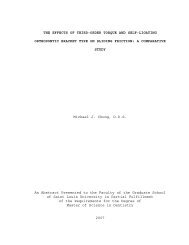Program Manual - Saint Louis University
Program Manual - Saint Louis University
Program Manual - Saint Louis University
You also want an ePaper? Increase the reach of your titles
YUMPU automatically turns print PDFs into web optimized ePapers that Google loves.
H. HCWs with active tuberculosis disease HCWs are unable to work until they are non-infectious. Documentation<br />
must be provided showing two weeks of effective therapy for active pulmonary tuberculosis are complete with a<br />
good clinical response. The HCW is cleared to continue patient care/work when the infectious status is known to<br />
be non-communicable.<br />
I. HCW NON-COMPLIANCE HCW compliance with Tuberculosis Screening programs is mandatory. This<br />
includes: pre-placement tuberculosis screenings and 2 step PPD testing, annual tuberculosis screening, increased<br />
risk department semi-annual tuberculosis screening, and post-exposure tuberculosis screening.<br />
1. Employee Health manager or physician will notify Human Resources or the department director that the<br />
HCW is not compliant. Human Resources or the department director will proceed according to individual<br />
company policy to resolve the non-compliance issues. Depending on company policy the HCW may be<br />
relieved from duty until the compliance issue is resolved.<br />
2. The Employee Health manager or physician will notify Human Resources when the HCW is compliant.<br />
J. Guidelines for interpreting a tuberculin skin test<br />
1. A tuberculin reaction of five millimeters or greater of induration is classified as positive in the following<br />
groups:<br />
a. HIV-infected persons<br />
b. Recent contacts of TB case<br />
c. Persons with fibrotic changes on chest radiograph consistent with old healed TB<br />
d. Patients with organ transplants and other immunosuppressed patients (receiving the equivalent of > 15<br />
mg/day of prednisone for > 1 month).<br />
2. A tuberculin reaction of 10 millimeters or greater of induration is classified as positive in persons who do not<br />
meet the preceding criteria but who have other risk factors for Tuberculosis. These include:<br />
a. Recent arrivals to the U.S. (< 5 years) from high-prevalence countries<br />
b. Injection drug users<br />
c. Residents and employees of high risk congregate settings (correctional facilities, nursing homes, homeless<br />
shelters, SLUCares, residential facilities)<br />
d. Mycobacteriology laboratory personnel<br />
e. Persons with medical conditions that place them at high risk (HIV infection; substance abuse; recent<br />
infection with M. tuberculosis; chest radiograph findings suggestive of previous TB; diabetes mellitus;<br />
silicosis; prolonged corticosteroid therapy and other immunosuppressive therapy; cancer of the head and<br />
neck; hematologic and reticuloendothelial diseases; end-stage renal disease; intestinal bypass or<br />
gastrectomy; chronic malabsorption syndromes; or low body weight)<br />
f. Children < 4 years of age<br />
g. Children and adolescents exposed to adults in high-risk categories<br />
3. A tuberculin reaction of 15 millimeters or greater of induration is classified as positive in persons with no<br />
known risk factors for TB.<br />
REFERENCE: Core Curriculum on Tuberculosis, 4th Edition, 2000, U.S. Department of Health and Human Services, Public<br />
Health Service, Centers for Disease Control and Prevention.<br />
“November 2001 – The Internet (HTML) version of the Core Curriculum on Tuberculosis is updated periodically. Therefore, the Internet<br />
version may differ from the print version.”<br />
Retrieved 12-09-04<br />
E-16

















